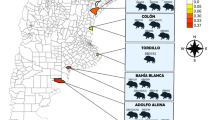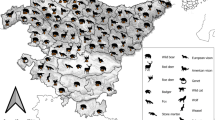Abstract
Anthropogenic activities have cumulatively led to the dramatic decline of world populations of vultures that currently face serious survival challenges in several regions of the world. In Portugal, the three resident species qualify as endangered and are under conservation efforts, mainly in the central east and south-east regions, where habitat protection and artificial feeding stations were implemented. Concurrently, the areas under protection are highly affected by tuberculosis (TB) in cattle and wild ungulates, whose potentially infected carcasses may naturally or artificially be used as feed by local vultures. In this work, we opportunistically surveyed populations of Eurasian griffon (Gyps fulvus) and Eurasian black vulture (Aegypius monachus) for the presence of Mycobacterium bovis. Nine pathogenic mycobacteria, including one M. bovis isolate, were cultured from the oropharynx of nine of the surveyed vultures (n = 55), sampled in recovery centres or in artificial feeding stations. Genotyping of the M. bovis strain indicated spoligotype SB0121, the most frequent type in Portugal, and a unique MIRU–VNTR profile that differed in two loci from the profiles of SB0121 bovine and deer strains from the same geographical area. The M. bovis-positive griffon exhibited poor clinical condition when admitted to the recovery centre; however, clinical evidence of TB was not present. Although the significance of M. bovis isolation in this vulture specimen could not be ascertained and despite the accepted notion that vultures are naturally resistant to microbial pathogens, the sanitary follow-up of Accipitridae vulture populations in TB-hotspot areas is essential to safeguard ongoing conservation efforts and also to evaluate the suitability of standing legislation on deliberate supplementary feeding schemes for menaced birds of prey.

Similar content being viewed by others
References
Bercovier H, Vincent V (2001) Mycobacterial infections in domestic and wild animals due to Mycobacterium marinum, M. fortuitum, M. chelonae, M. porcinum, M. farcinogenes, M. smegmatis, M. scrofulaceum, M. xenopi, M. kansasii, M. simiae, and M. genavense. Rev Sci Tech 20:265–290
BirdLife International. 2013. Aegypius monachus. The IUCN Red List of Threatened Species 2013: e.T22695231A48120733. http://dx.doi.org/10.2305/IUCN.UK.2013-2.RLTS.T22695231A48120733.en. Downloaded on 03 January 2016.
BirdLife International. 2015. Gyps fulvus. The IUCN Red List of Threatened Species 2015: e.T22695219A80159120. http://dx.doi.org/10.2305/IUCN.UK.2015-4.RLTS.T22695219A80159120.en. Downloaded on 03 January 2016.
BirdLife International. 2015. Neophron percnopterus. The IUCN Red List of Threatened Species 2015: e.T22695180A85062680. Downloaded on 03 January 2016.
Botelho A, Canto A, Leão C, Cunha MV (2015) Clustered regularly interspaced short palindromic repeats (CRISPRs) analysis of members of the Mycobacterium tuberculosis complex. Methods Mol Biol 1247:373–389
Cabral MJ, Almeida J, Almeida PR, Delliger T, Ferrand de Almeida N, Oliveira ME, Palmeirim JM, Queirós AI, Rogado L, Santos-Reis M (editors) (2005) Livro Vermelho dos Vertebrados de Portugal. Instituto da Conservação da Natureza
Camiña A, Garrido JR, Martin J, Lopez-Hernández CH, Alfaro R (2014) A new threat to European vultures. Science 344(6180):150
Corte´s-Avizanda A, Carrete M, Donázar JA (2010) Managing supplementary feeding for avian scavengers: guidelines for optimal design using ecological criteria. Biol Conserv 143:1707–1715
Costa P, Ferreira AS, Amaro A, Albuquerque T, Botelho A, Couto I, Cunha MV, Viveiros M, Inácio J (2013) Enhanced detection of tuberculous mycobacteria in animal tissues using a semi-nested probe-based real-time PCR. Plos one 8(11):e81337
Cunha MV, Monteiro M, Carvalho P, Mendonça P, Albuquerque T, Botelho A (2011) Multihost tuberculosis: Insights from the Portuguese control program. Vet Med Intl 2011:795165. doi:10.4061/2011/795165
Cunha MV, Matos F, Canto A, Albuquerque T, Alberto JR, Aranha JM, Vieira-Pinto M, Botelho A (2012) Implications and Challenges of Tuberculosis in Wildlife Ungulates in Portugal: a Molecular Epidemiology Perspective. Res Vet Sci 92:225–235
Cuthbert RJ, Taggart MA, Prakash V, Chakraborty SS, Deori P, Galligan T, Kulkarni M, Ranade S, Saini M, Sharma AK, Shringarpure R, Green RE (2014) Avian scavengers and the threat from veterinary pharmaceuticals. Philos Trans R Soc Lond B Biol Sci 369:1656
Direção Geral de Alimentação e Veterinária (2011) Edital nº1: Tuberculose em Caça Maior, 29th april 2011, Lisboa, Portugal
Direção Geral de Alimentação e Veterinária (2013) Plano Nacional de Erradicação da Tuberculose Bovina, Lisboa, Portugal
Donazar JA, Palacios CJ, Gangoso L, Ceballos O, Gonzalez MJ, Hiraldo F (2007) Conservation status and limiting factors in the endangered population of Egyptian vulture (Neophron percnopterus) in the Canary Islands. Biol Conserv 107:89-97
Donázar JA, Margalida A, Campión D (2009) Vultures, feeding stations and sanitary legislation: a conflict and its consequences from the perspective of conservation biology. Sociedad de Ciencias Aranzadi, San Sebastian, Spain
Donázar JA, Cortés-Avizanda A, Carrete M (2010) Dietary shifts in two vultures after the demise of supplementary feeding stations: consequences of the EU sanitary legislation. Eur J Wildl Res 56:613–621
Duarte EL, Domingos M, Amado A, Botelho A (2008) Spoligotype diversity of Mycobacterium bovis and Mycobacterium caprae animal isolates. Vet Microbiol 130:415–421
Duarte EL, Domingos M, Amado A, Cunha MV, Botelho A (2010) MIRU–VNTR typing adds discriminatory value to groups of Mycobacterium bovis and Mycobacterium caprae strains defined by spoligotyping. Vet Microbiol 143:299–306
Duriez O, Eliotout B, Sarrazin F (2011) Age identification of Eurasian Griffon Vultures Gyps fulvus in the field. Ringing & Migration 26 (1):24–30
Green RE, Taggart MA, Devojit D, Pain DJ, Kumar CS, Cunningham AA, Cuthbert R (2006) Collapse of Asian vulture populations: risk of mortality from residues of the veterinary drug diclofenac in carcasses of treated cattle. J Appl Ecol 43:949–956
Heatley JJ, Mitchell MM, Roy A, Cho DY, Williams DL, Tully TN Jr (2007) Disseminated mycobacteriosis in a bald eagle (Haliaeetus leucocephalus). J Avian Med Surg 21:201–209
Hernández AE, Margalida A (2009) Poison-related mortality effects in the endangered Egyptian Vulture (Neophron percnopterus) population in Spain. Eur J Wildl Res 55:415–423
Hoenerhoff M, Kiupel M, Sikarskie J, Bolin C, Simmons H, Fitzgerald S (2004) Mycobacteriosis in an American bald eagle (Haliaeetus leucocephalus). Avian Dis 48:437–441
Houston DC, Cooper, JE (1975) The digestive tract of the whiteback griffon vulture and its role in disease transmission among wild ungulates. J Wildl Dis 11:306–313
Jones MP (2006) Selected Infectious Diseases of Birds of Prey. J Exotic Pet Med 15:5–17
Lumeij JT, Dorrestein GM, Stam JWE (1981) Recent advances in the study of raptor diseases: observations on tuberculosis in raptors. In: Cooper JE, Greenwood AG (eds.): Proceedings: International Symposium on Diseases of Birds of Prey. Chiron Publications, Keighley, West Yorkshire, UK. 137–139
Margalida A, Donázar JA, Carrete M, Sánchez-Zapata JA (2010) Sanitary versus environmental policies: fitting together two pieces of the puzzle of European vulture conservation. J Appl Ecol 47:931–935
Margalida A, Sánchez-Zapata JA, Blanco G, Hiraldo F, Donázar JA (2014) Diclofenac approval as a threat to Spanish vultures. Conserv Biol 28:631–632
Matos F, Cunha MV, Canto A, Albuquerque T, Amado A, Botelho A (2010) Snapshot of Mycobacterium bovis and Mycobacterium caprae infections in livestock in an area with a low incidence of bovine tuberculosis. J Clin Microbiol 48:4337–4339
Millán J, Negre N, Castellanos E, de Juan L, Mateos A, Parpal L, Aranaz A (2010) Avian mycobacteriosis in free-living raptors in Majorca Island, Spain. Avian Pathol 39:1–6
Niemann S, Harmsen D, Rüsch-Gerdes S, Richter E (2000) Differentiation of clinical Mycobacterium tuberculosis complex isolates by gyrB DNA sequence polymorphism analysis. J Clin Microbiol 38:3231–3234
Ogada DL, Keesing F, Virani MZ (2012) Dropping dead: causes and consequences of vulture population declines worldwide. Ann N Y Acad Sci 1249:57–71
Ogada DL, Torchin ME, Kinnaird MF, Ezenwa VO (2012) Effects of vulture declines on facultative scavengers and potential implications for mammalian disease transmission. Conserv Biol 26:453–460
OIE (2008) Manual of Diagnostic Tests and Vaccines for Terrestrial Animals, Sixth edition
Rodriguez-Campos S, Schürch AC, Dale J, Lohan AJ, Cunha MV, Botelho A, De Cruz K, Boschiroli ML, Boniotti MB, Pacciarini M, Garcia-Pelayo MC, Romero B, de Juan L, Domínguez L, Gordon SV, van Soolingen D, Loftus B, Berg S, Hewinson RG, Aranaz A, Smith NH (2012) European 2- a clonal complex of Mycobacterium bovis dominant in the Iberian Peninsula. Infect Genet Evol 12:866–872
Roth A, Reischl U, Streubel A, Naumann L, Kroppenstedt RM, Habicht M, Fischer M, Mauch H (2000) Novel diagnostic algorithm for identification of mycobacteria using genus-specific amplification of the 16S-23S rRNA gene spacer and restriction endonucleases. J Clin Microbiol. 38(3):1094–104.
Schrenzel M D (2012) Molecular Epidemiology of Mycobacteriosis in Wildlife and Pet Animals. Vet Clin North Am Exot Anim Pract, 15:1–23
Shultz S, Baral HS, Charman S, Cunningham AA, Das D, Ghalsasi GR, Goudar MS, Green RE, Jones A, Nighot P, Pain DJ, Prakash V (2004) Diclofenac poisoning is widespread in declining vulture populations across the Indian subcontinent. Proc Biol Sci 271:S458-S460
Skoric M, Fictum P, Frgelecova L, Kriz P, Slana I, Kaevska M, Pavlik I (2010) Avian tuberculosis in a captured ruppell’s griffon vulture (Gyps ruppellii): a case report. Vet Med Czech, 55:348–352
Smits JEG, Fernie KJ (2012) Avian wildlife as sentinels of ecosystem health. Comp Immunol Microbiol Infect Dis 36:333–342
Telenti A, Marchesi F, Balz M, Bally F, Böttger EC, Bodmer T (1993) Rapid identification of mycobacteria to the species level by polymerase chain reaction and restriction enzyme analysis. J Clin Microbiol 31:175–178
Tell LA, Ferrell ST, Gibbons PM (2004). Avian mycobacteriosis in free-living raptors in California: 6 cases (1997–2001). J Avian Med Surg 18:30–40
Vieira-Pinto, M, Alberto J, Aranha J, Serejo J, Canto A, Cunha MV, Botelho A (2011) Combined evaluation of Bovine Tuberculosis in wild boar (Sus scrofa) and red deer (Cervus elaphus) from Central-East Portugal. Eur J Wildl Res 576:1189–1201
Witte CL, Hungerford LL, Papendick R, Stalis IH, Ri-deout BA (2010) Investigation of factors predicting disease among zoo birds exposed to avian mycobacteriosis. J Am Vet Med Assoc 236:211–218
Xirouchakis S M, Mylonas M (2005) Status and structure of the griffon vulture (Gyps fulvus) population in Crete. Eur J Wildl Res 51:223–231
Author information
Authors and Affiliations
Corresponding author
Ethics declarations
Conflict of interest
The authors declare that no competing interests exist.
Rights and permissions
About this article
Cite this article
Cunha, M.V., Azorín, B., Peñuela, R.G. et al. Exposure of Threatened Accipitridae to Mycobacterium bovis Calls for Active Surveillance. EcoHealth 14, 310–317 (2017). https://doi.org/10.1007/s10393-017-1226-0
Received:
Revised:
Accepted:
Published:
Issue Date:
DOI: https://doi.org/10.1007/s10393-017-1226-0




